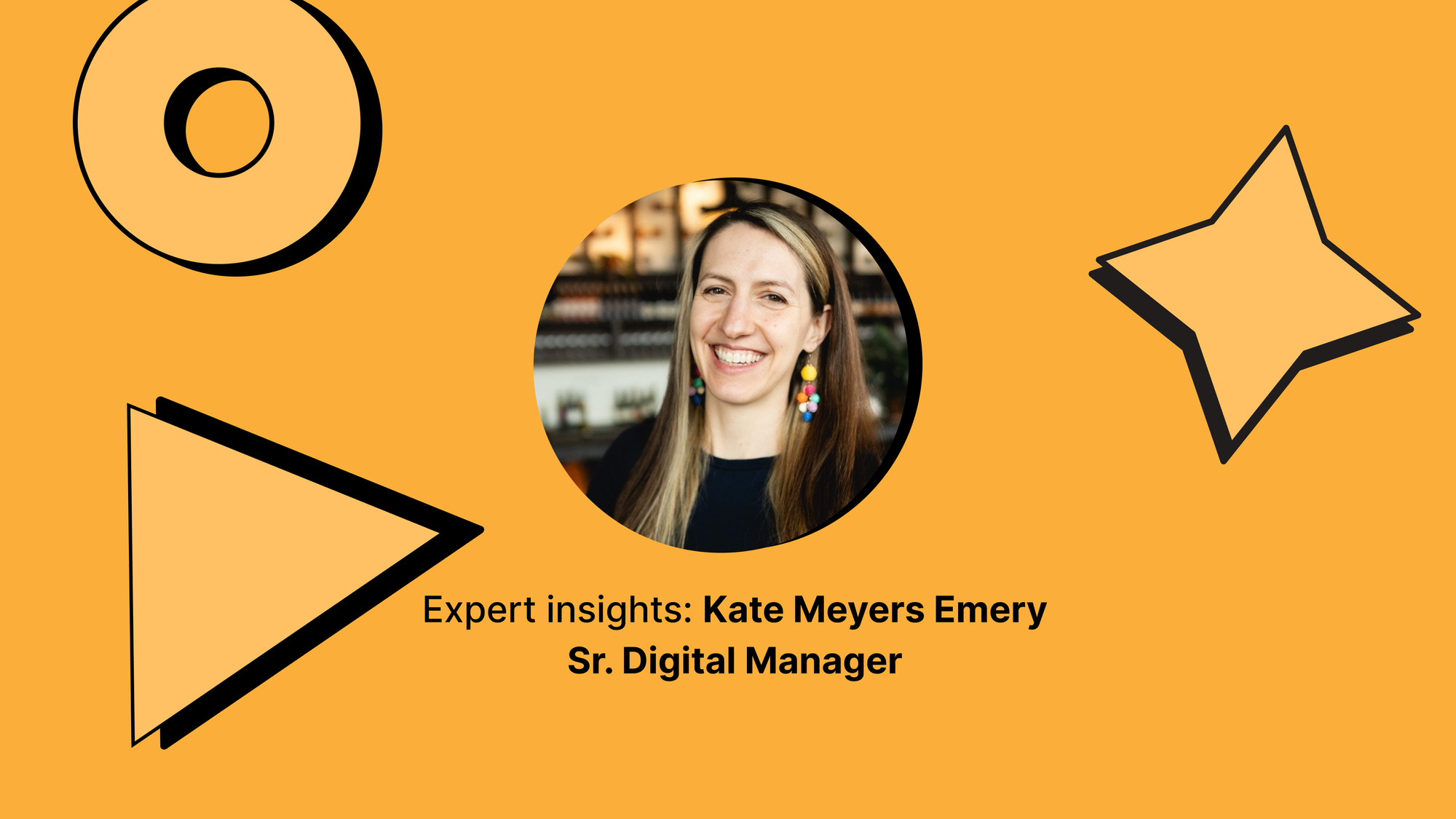[What Data Says] Zero-Click Content for Social Media
Unlock the potential of zero-click content for social media. Drive engagement and build connections through compelling, shareable posts.


Zero-click content is my default play on social right now. I define it simply: give people the whole answer in-feed, no click required. Platforms reward it, people prefer it, and it compounds brand recall faster than link-first posts.
Why it matters now: feeds prioritize content that keeps users on-platform, and audiences prefer frictionless, mobile-native value. When I publish complete, skimmable insights as carousels, documents, or short videos, I see more reach, more saves, and better conversation quality. Links still have a place, but only when intent is high.
Let me show you further the in’s and out’s of zero click content on social and how to leverage it for your brand.
Executive summary
- On Facebook, zero-click content outperforms posts with links across all content formats.
- Albums, photos and Reels on Facebook get an double the engagement when there are no link insertions
- Surprisingly, 82.2% of the entire content brands post on Facebook consist of link-free posts.
- On LinkedIn, native documents and text posts with links slighlty outperfom those without.
- 67.5% onf the content posted on LinkedIn is zero-click content.
What is zero-click content?
Put shortly, zero-click content is content that gives the full answer in-feed. Instead of treating social as a redirect mechanism, zero-click designs posts as complete experiences: a self-contained insight, framework, how-to, or narrative that solves a user’s need right now.
Core principles:
- Deliver completeness: A post can stand on its own without a link. If someone never clicks, they still get the value.
- Native-first formatting: Optimize for the platform’s best-performing native formats (e.g., LinkedIn documents, Instagram carousels, short-form video).
- Signal density: Use hooks, skimmability, and visual hierarchy to concentrate information and keep users engaged.
- Repeatable patterns: Build a small set of reliable content patterns (e.g., frameworks, checklists, industry snapshots) you can execute weekly.
How it differs from link-first distribution:
- Link-first asks the algorithm and the user to do extra work. Zero-click reduces friction and aligns with platform incentives.
- Instead of “read more here,” zero-click says “here’s the answer right now,” followed by soft, non-disruptive next steps.
Why platforms reward it:
- Dwell and interaction are leading quality signals. When users spend more time in your post—saving, sharing, commenting—the platform sees proof of value and extends reach to new audiences.
- Platforms optimize for retention and session length. Content that keeps users engaged in-feed fits that goal—so your distribution benefits.
Now, if you were to ask me about a brand that nails this on LinkedIn, I’ll probably say Canva.
What they do well: Their sales frameworks show up as native documents with practical, bite-sized steps. When they do link, it’s a low-friction nudge after the value is delivered.
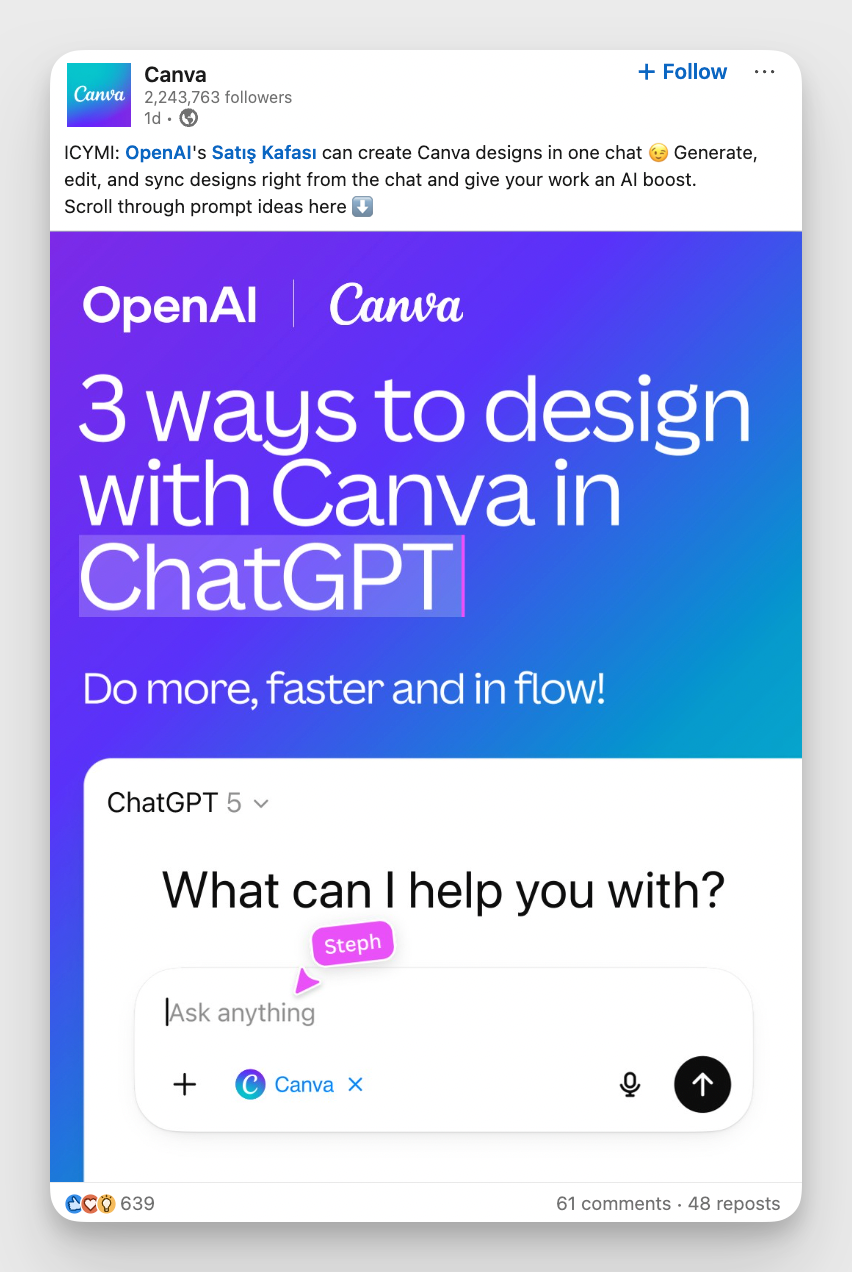
Why zero-click matters now more than ever?
Simple. Because social platforms and audiences shift. Here are my takeaways on why zero-click content should make a part of your strategy as soon as possible.
- Platform incentives: LinkedIn and Facebook boost posts that keep users in-feed. Link previews usually lose that distribution lottery. Zero-click aligns your content with the algorithm’s goals.
- Audience behavior: On mobile, people want answers now. If your post can solve a problem in 30–90 seconds, it earns more attention than a link would.
- Discovery changes: With AI summaries and in-feed research, being present with native, bite-sized expertise builds trust first. Depth can come later via a smart link strategy.
This shift does not eliminate the need for destination content (e.g., long-form articles, product pages). It reorders it. First, earn attention and trust where the audience is. Then, nudge qualified interest along more intentional paths—without sabotaging reach.
Why integrate more zero-click content into your strategy?
Here’s what I consistently see when teams lean into zero-click:
- More organic reach and visibility: Native value = stronger distribution signals.
- Deeper in-feed engagement: More saves and shares, better comments, and higher dwell time.
- Brand recall and trust: Repetition of useful, distinct POVs in the feed cements memory.
- Lower friction for education: Short-hops to clarity mean less drop-off.
- Cost efficiency: A solid zero-click cadence reduces your dependency on paid to be seen.
- Demand creation: Over time, it lifts branded search, direct traffic, and unsolicited inbound.
Let’s take Notion as an example.
What they do well: Their education-forward, native posts (documents, short video) teach creatives quick wins, which builds authority and keeps their products top-of-mind. My take: their content pairs aspiration with tangible “how,” which is the sweet spot.
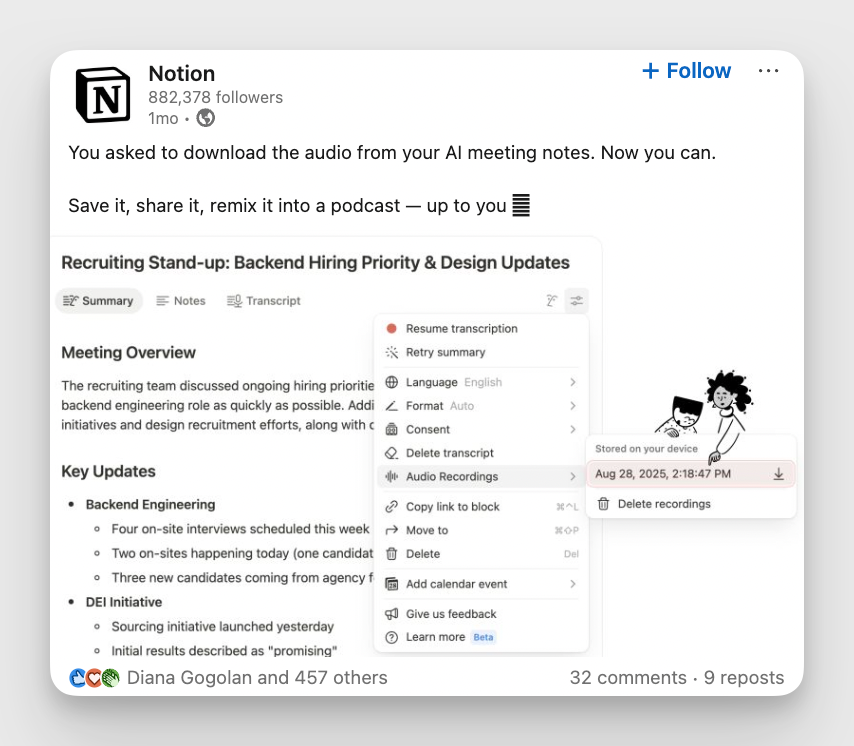
What does the data reveal about zero-click content?
Zero-click content strategy for LinkedIn
When I looked at how brands post on LinkedIn, I found that most of them already lean toward zero-click content — about 67.5% of posts don’t include links, while only 32.5% do.
That makes sense once you see how engagement changes depending on whether there’s a link or not.

Looking at engagement rates across post types, the data paints a nuanced picture. While zero-click content generally performs better, there are a few exceptions worth noting.
Here’s what stands out:
- Multi-image posts still benefit from being zero-click. Carousels without links see slightly higher engagement, confirming that people like to swipe through content directly in the feed without extra steps.
- Native documents perform slightly better with links — a rare exception. This could be because, in some cases, linked documents guide users toward valuable resources (like whitepapers or reports), adding more context and encouraging interaction beyond the feed.
- Videos maintain their in-feed power. Posts without links continue to perform better for video content, which thrives on native views and quick reactions. Keeping users watching without sending them elsewhere pays off.
- Single-image posts are steady — links or no links. Engagement here remains almost identical, suggesting that image performance depends more on the visual itself than on whether there’s a link attached.
- Text posts slightly favor link-based content. The difference is small, but it hints that short, text-based updates might benefit from including a link when there’s additional context or value waiting off-platform.
Overall, this dataset adds an interesting twist: zero-click content isn’t always the winner in every case, but it still dominates most formats. When audiences do engage with link-based content, it’s often because the link feels relevant and seamlessly connected to the conversation — not just tacked on for traffic.
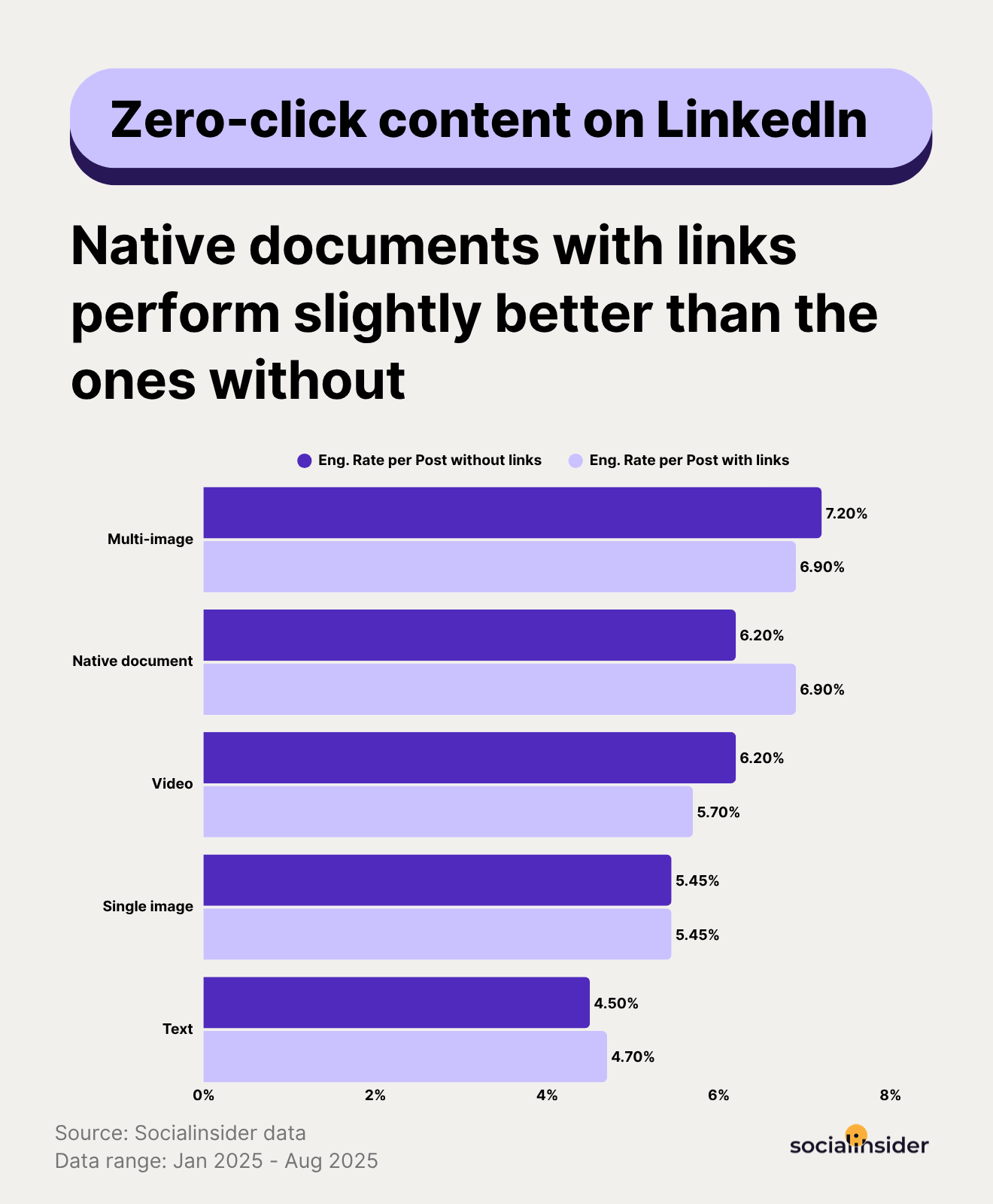
Zero-click content strategy for Facebook
In Facebook’s case, things do not differ much.
On Facebook, most brands already prioritize zero-click content. In fact, around 80.2% of posts don’t include links, while only 19.8% do.
That massive difference shows that marketers are well aware of how Facebook’s algorithm tends to favor in-feed content. Posts that keep users scrolling, watching, or reacting — instead of clicking away — have a much better shot at visibility and engagement.

When we dig deeper into engagement by post type, the pattern stays consistent — zero-click content wins again.
Across all formats, Facebook posts without links outperform those with links, often by a noticeable margin.
Albums and Reels lead the way, both seeing engagement rates around 0.25% when there’s no link attached. That’s nearly double the engagement compared to posts that include a link.
Even photo posts, which have always been a Facebook staple, follow the same trend — stronger engagement when users aren’t asked to leave the platform. And the same applies for status posts, scoring an average engagement rate of 0.13% when there is no link included, compared to 5% when there is.
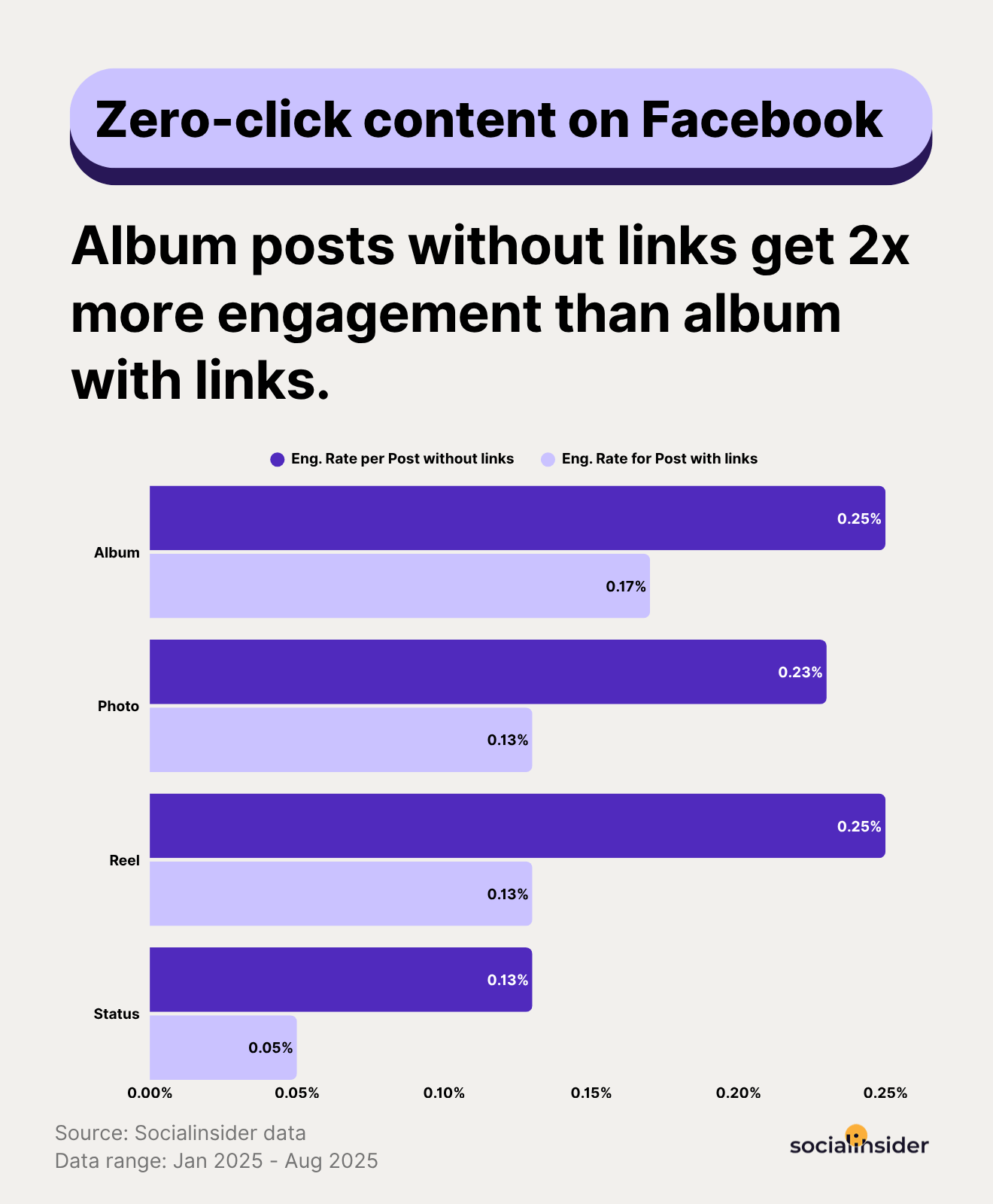
How to blend link usage and zero-click content?
Don’t get me wrong, while zero-click content proves to be more effective, it doesn’t mean you should cut off all your links, especially the important ones, such as landing pages for a product launch, for example. The magic lies in finding the right balance.
Here’s the mix I recommend based on the results we’ve had with our very own Socialinsider channels:
- 70% zero-click education/authority: Frameworks, checklists, how-tos, and native summaries of your best knowledge.
- 20% conversation/community: Hot takes with insights, prompts, polls, and customer spotlights that invite discussion.
- 10% link-based conversion: Long-form pieces, events, product updates, or offers—used sparingly and supported by retargeting.
And lastly, here’s how we approach zero-click content creation, following some simple principles:
- TEA (Teach–Explain–Apply)
- Teach: Name the idea in one sharp line.
- Explain: Add context with 2–4 bullets or a short story.
- Apply: Give the checklist or the one-page playbook right there in the feed.
- Why it works: People can act immediately. Saves go up because it’s a ready-made reference.
- PIP (Problem–Insight–Playbook)
- Problem: State the pain and what’s at stake.
- Insight: Show what most people miss and why.
- Playbook: Outline the exact steps, decision criteria, and pitfalls.
- Why it works: It builds authority without hype. It’s consultative, not promotional.
- DTA (Data–Takeaway–Action)
- Data: Share a pattern or chart (native visual if possible).
- Takeaway: Translate the data into a plain-English conclusion.
- Action: Give the smallest next step they can try today.
- Why it works: You’re not just presenting numbers—you’re helping people move.
And here’s my brand example: Hubspot.
What they do well: They publish native frameworks and checklists on LinkedIn first, then add a soft “more if you want it” link at the end or in the comments. The link never carries the weight—the post does. My take: they earn distribution and trust in-feed, then route only the most interested to long-form.
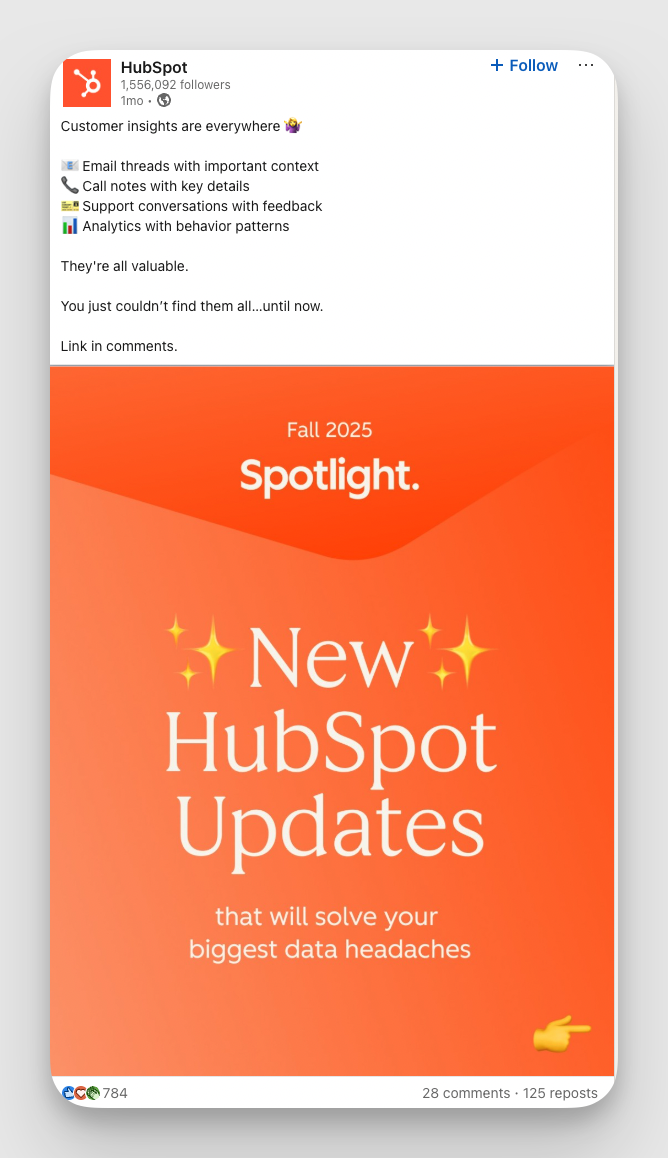
How to measure the effectiveness of zero-click content?
While zero-click content’s impact on sales may not be as easy to track as in the case of links, it doesn’t mean that native content is solely meant to increase brand awareness.
My take? To effectively evaluate the success of your link-free content, have KPIs mapped by funnel staged for it. Here’s what I mean by that:
- Awareness: measure reach, impressions, follower growth velocity.
- Consideration: monitor saves, shares, comments per impression, average watch time, completion rate, profile visits.
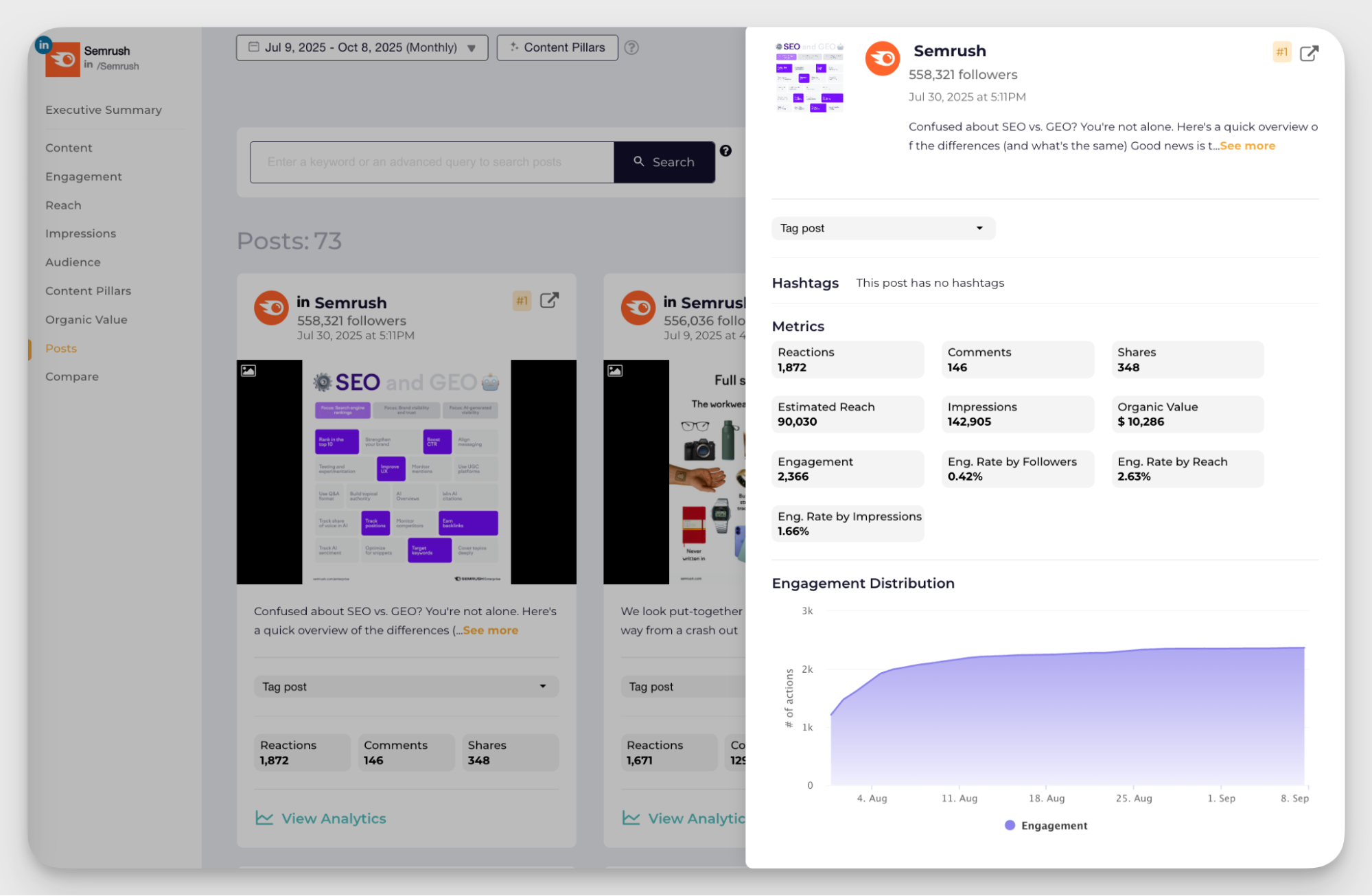
- Conversion proxies: track DMs, replies that express buying intent, followers gained during zero-click campaigns.
- Loyalty/advocacy: monitor repeat engagers, volume and quality of UGC, community thread depth, Group engagement velocity, returning viewers.
How to win on social with zero-click content?
You may already know it, but it won’t hurt hearing it twice: repurposing is the secret.
Here’s how I advice you to approach it:
- Source once, distribute many: turning one research asset into multi-platform zero-click formats
- Design system and templates for speed (carousel, thread, doc, short)
- Scale with UGC, and employee advocacy programs
And one final tip that I have for you is to identify format winners and double down on those. For example, if a specific content pillar works best in video format and as carousels, try switching info between these two.
Examples of applied zero-click content strategies for B2B and B2C businesses
Certainly, B2B businesses operate differently from B2C companies, from the main platform leveraged to more general marketing and campaign approaches. But ultimately, regardless we’re talking about the B2B or B2C sphere, the end consumer is still a human, which means, some needs are incredibly similar. Such the one of having their struggles understood.
Our earlier focus on LinkedIn and Facebook benchmarks for zero click content performance was obviously far from being random, as these are the leading platforms for brand awareness in the two business categories.
Let’s take a peak of how zero click content can be leveraged on these two platforms, with strategies tailored to both business sectors.
For B2B
Situation: A mid-market B2B software brand wanted to grow awareness in a crowded category without overspending on paid distribution.
- Approach:
- Shifted to a zero-click series: weekly LinkedIn documents that distilled one problem, one mental model, and a simple implementation checklist.
- Added a mid-week carousel with one customer “before/after” breakdown (anonymized), and a Friday community prompt to collect objections and questions.
- Measured engagement-per-reach, saves, and comment depth as primary KPIs; branded search lift over 60–90 days as a secondary signal.
- Outcome:
- Consistent reach and higher quality signals week over week.
- Decision-makers began citing specific frameworks in inbound discovery calls.
- The brand’s analysts became recognizable names in category conversations.
For B2C
Situation: A consumer brand with strong product-market fit wanted to drive word-of-mouth and organic reach without heavy link promotion on Facebook.
- Approach:
- Introduced a twice-weekly series of native text + image explainers focused on troubleshooting and quick wins.
- Added one short-form video per week that demonstrated a “1-minute upgrade.”
- Measured saves, shares, reach rate, and comment quality; monitored DM inquiries as a qualitative lead indicator.
- Outcome:
- Native explainers became the top driver of saves and shares.
- The brand observed more product questions and peer recommendations in comments and DMs.
- This created a reliable organic engine to pair with targeted link posts when key launches required traffic.
Common mistakes to avoid
Since I know sometimes there’s a bit of a reluctance to leverage zero-click content, for those trying to test a strategy focused on this type of content, here are a couple of pitfalls I suggest avoiding:
- Walls of text and weak hooks: Dense, unstructured posts get skipped. Use skimmable formatting, numbered steps, and a clear payoff early.
- Ignoring quality signals: Saves, shares, and comment depth are early indicators of momentum. Track them—don’t optimize solely for likes.
- One-size-fits-all: Platform-native patterns matter. What wins on LinkedIn documents won’t automatically work on Instagram carousels or TikTok micro-lessons.
- Stopping too soon: Zero-click benefits compound with consistency. Expect several weeks of steady posting and iteration before the compounding effects show up in both reach and brand signals.
Final thoughts
Zero-click content isn’t about starving your site of traffic. It’s about earning attention and trust first—where your audience already is—so that when you do drop a link, you’ve already won the right to be heard. In my experience, a steady zero-click cadence boosts reach, lifts the quality of engagement, and puts your brand’s ideas in more minds, more often.
FAQs on zero-click content
What metrics should I track to measure the success of zero-click content?
To measure the impact of zero-click content, focus on engagement metrics like post impressions, likes, comments, shares, time spent on posts, profile visits, and follower growth. These metrics clearly show how well your content is resonating with your audience.
Can zero-click content work across all platforms?
Absolutely! You just need to tweak it to fit each platform’s style. On LinkedIn, you might use a carousel with key insights, while Instagram loves short, snappy Reels. For X (Twitter), a well-structured thread works wonders. Tailor your approach, and you’re good to go.
What are the long-term benefits of using zero-click content?
Zero-click content might not drive tons of traffic to your website right away, but it does something even better. It builds a loyal, engaged audience over time. More trust leads to more followers, and eventually, more conversions. It’s a slower process, but one that pays off long term.
Analyze your competitors in seconds
Track & analyze your competitors and get top social media metrics and more!
You might also like
Improve your social media strategy with Socialinsider!
Use in-depth data to measure your social accounts’ performance, analyze competitors, and gain insights to improve your strategy.





